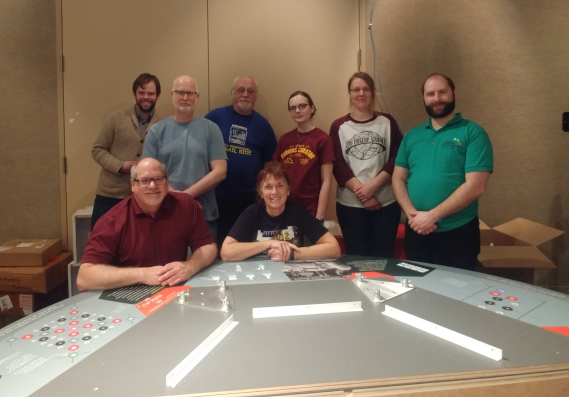The 2019 ACS Midland Section Centennial

The final “take-down team” with the last piece of the exhibit: front (L to R): Dr. Jay Martin (CMU), Dr. Gina Malczewski (ACS); standing (L to R): Jake Huss (Midland Historical Society), John Metcalf (designer), Jim Malek (ACS), Alex Gamicchia (CMU), Casey Peacock (CMU) and Marc Van Horn (CMU).
In 2016, visionary members of the ACS-Midland Section began to conceptualize what their centennial observance would look like. They had secured the right to host the 2019 ACS Central Regional Meeting (CERM) and began to build partnerships with groups that could support a historical exhibit that would both commemorate and interpret the contributions of Midland Section members. That effort ultimately resulted in connections with multiple specialists in museum exhibition and educational programming, including the Midland Center for the Arts, the Herbert D. Doan Midland County History Center, the Museum Studies Program at Central Michigan University, and Good Design LLC.
As a result of all this hard work, the ACS centennial exhibit opened at the Doan Midland County History Center on May 11, 2019. Associated educational programming was also available through the rest of the year.
The exhibit closed in December 2019 and was moved to storage owned by the Central Michigan University Museum. A new installation of “A Century of Science and Service”, with some changes, re-opened at Rowe Hall on the CMU campus on September 22, 2022, and is now available for public visits.
If you are interested in visiting or have questions, please refer to the link above.
Contact Us
Email: centennial@midlandacs.org
Address:
ACS-Midland Section
PO Box: 2695
Midland, MI 48641
ACS-Midland Section Website: https://www.midlandacs.org
American Chemical Society Website: https://www.acs.org
Sites interested in hosting A Century of Science and Service exhibit in the future are encouraged to contact ACS exhibit committee head Regina Malczewski at reginamalczewski@gmail.com.





